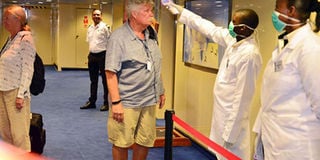This is how our behaviour spreads diseases

A health inspector screens tourists at the Port of Mombasa on February 13, 2020, as the world battles the spread of coronavirus. PHOTO | LABAN WALLOGA | NATION MEDIA GROUP
What you need to know:
- Cultural practices are strong and deep and need a strategic approach for the preventive message to sink home and elicit a positive behaviour change.
- Let us change risk behaviours in times of disease epidemics. It is much easier and effective when initiated by the would-be beneficiaries: me and you.
Human behaviour is at the core of most infectious disease outbreaks.
And while human survival is pegged on them, humanity must learn to change or perish.
How we prepare and eat food, the disposal of bodily and other wastes, how we carry out our cultural practices like burial, and our interactions with fellow human beings and animals are among the risk behaviours that need a relook in times of epidemics.
They offer routes for viruses, bacteria and fungi to jump from a source of infection to a healthy population.
Behaviour change is a disease preventive measure but it takes time for a critical mass to answer the clarion call and just enough for the disease to spread and get out of hand.
This pattern has been documented over time with minimal take-home lessons for the living.
Late last year, coronavirus disease was first reported in Wuhan, China. The Covid-19, as it has come to be identified, has spread like bushfire across the globe and has claimed over 1,300 lives.
CULTURAL PRACTICES
Before that, central African countries had reported Ebola epidemics spreading fast across borders. HIV/Aids came in a similar fashion and has achieved a global presence.
Most of the health messages around Covid-19 target human behaviour. We are being encouraged to wash our hands, remain indoors, avoid crowds and public transport when we suspect we have the disease, but the message is not yet home.
One of the greatest challenges human behaviourists and health communication experts faced while trying to contain the spread of Ebola in DR Congo was minimising contact between the living and the dead in funerals.
Cultural practices are strong and deep and need a strategic approach for the preventive message to sink home and elicit a positive behaviour change.
HIV/Aids is mainly spread through sexual contact; its prevention through behaviour change has taken decades of sustained campaign to register a measure of success.
So it all boils down to a low-risk perception index perpetuated by our sociocultural latitudes.
RISK PERCEPTION
You probably had common cold and subconsciously poked your nose, then went ahead to greet people, hold onto a bus seat and touch door knobs at home and office.
But when everybody in your vicinity came down with a cold, you did not feel the urge to confess your sins. “After all, colds have never killed anyone,” you defended your bad behaviour.
Such is the working of the human mind, the puzzle behavioural scientists have to crack when developing behaviour change communication (BCC) strategies.
Risk perception is how easily we associate a specific behaviour or action to an inherent risk.
When a risk perception is low then one shall engage in risky behaviour without giving it a second thought. One will smoke without associating it with the risk of lung cancer.
BEHAVIOUR CHANGE
One will drink alcohol and drive home without thinking about an eminent fatal accident as a result, or engage in risky sexual behaviours oblivious of the many sexually transmitted diseases.
Others will use their car as a wheelchair, denying their body of the rejuvenating effects of exercise.
Let us change risk behaviours in times of disease epidemics. It is much easier and effective when initiated by the would-be beneficiaries: me and you.
Dr Othieno (PhD) is a veterinary doctor and health communication expert. [email protected].




